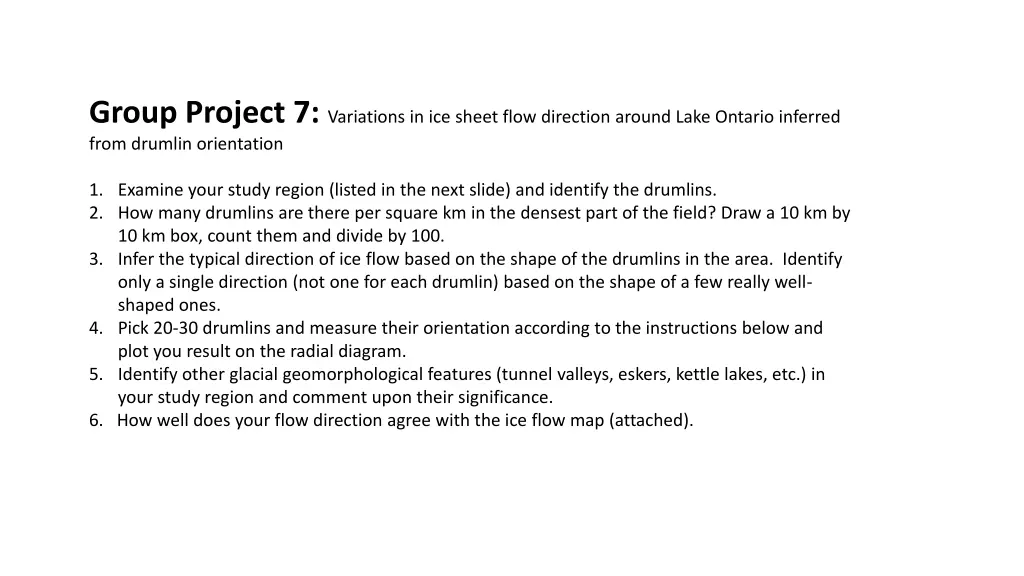
Ice Sheet Flow Variations around Lake Ontario: Drumlin Orientation Study
Explore variations in ice flow direction around Lake Ontario through drumlin orientation analysis in regions of Ontario, Canada, and Western New York State. Identify drumlins, assess flow directions, measure orientations, and compare findings with ice flow maps.
Download Presentation

Please find below an Image/Link to download the presentation.
The content on the website is provided AS IS for your information and personal use only. It may not be sold, licensed, or shared on other websites without obtaining consent from the author. If you encounter any issues during the download, it is possible that the publisher has removed the file from their server.
You are allowed to download the files provided on this website for personal or commercial use, subject to the condition that they are used lawfully. All files are the property of their respective owners.
The content on the website is provided AS IS for your information and personal use only. It may not be sold, licensed, or shared on other websites without obtaining consent from the author.
E N D
Presentation Transcript
Group Project 7: Variations in ice sheet flow direction around Lake Ontario inferred from drumlin orientation 1. Examine your study region (listed in the next slide) and identify the drumlins. 2. How many drumlins are there per square km in the densest part of the field? Draw a 10 km by 10 km box, count them and divide by 100. 3. Infer the typical direction of ice flow based on the shape of the drumlins in the area. Identify only a single direction (not one for each drumlin) based on the shape of a few really well- shaped ones. 4. Pick 20-30 drumlins and measure their orientation according to the instructions below and plot you result on the radial diagram. 5. Identify other glacial geomorphological features (tunnel valleys, eskers, kettle lakes, etc.) in your study region and comment upon their significance. 6. How well does your flow direction agree with the ice flow map (attached).
Drumlin Fields in the general vicinity of Lake Ontario G1. Ontario, Canada near Rice Lake G2. Western New York State, near Marbletown and west of Route 14 G3. Western New York State, near Weedsport and east of Route 14 G4. Western New York State, near Wheatland Center and east of Route 14 (incidental discovery: what is near the intersections of Lacey Rd and Cameron Rd in Caledonia NY and what is it telling you?) G5. Ontario, Canada near Flamborough G6. Ontario, Canada near Madoc Junction and east of Route 14 (incidential discovery: what s by Oak Lake?)
Measuring and plotting the direction of ice flow with PowerPoint Step 4. Read the rectangle s rotation angle (in the 0-360 range) from the Formal Shape menu. You need to be careful that you re not 180 degrees off with the angle. In this example, the downslope direction is N208E Step 1. Copy the map to Powerpoint. Step 2. Select a upward-pointing arrow and draw it onto the map centered on the drumlin Step 3. Rotate it CLOCKWISE until it aligns with ice sheet flow direction as deduced from the shape of the drumlin
0 N Step 5. Assess whether your measurement is good, very good or excellent. It helps to have a short written rubric that guides the assessment, so develop one that is informed by your actual observations of the drumlins in your study area. 330 30 60 300 Let s say you assess a particular drumlin as very good (VG).. W 270 VG G E 90 E Step 6. Transfer it to the polar diagram with the correct angle and a length that reflects your quality assessment. Note that the rings increase in diameter from G to E . See the next two slides for a suggestion on how to do this efficiently. 120 240 150 210 180 S
0 N The diagram is for one arrow. It should start out blank, so if it has a previous arrow in it, just delete that arrow. 330 30 60 300 Cut and paste the arrow from the map, move it so that its tail is at the center of this diagram, overlay it with a line-ending- with-an-arrow of the same angle but length reflecting quality, and then delete the original arrow. W 270 VG G E 90 E 120 240 150 210 180 S
0 N This diagram is for all the arrows 330 30 Now cut an paste each arrow here, so that you wind up with a diagram with many arrows on it. 60 300 W 270 VG G E 90 E 120 240 150 210 180 S
Gn study area Step 7. Select and group: your polar diagram and copy-and-paste it into the space shown below. Annotate the map with the red dot showing your study area (and update the n in the title, above). Make this the last slide in your Group Results file Radial plot goes here 18,000 year ago
